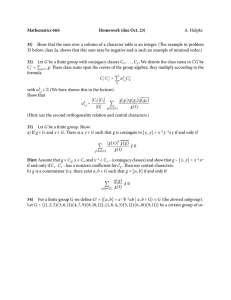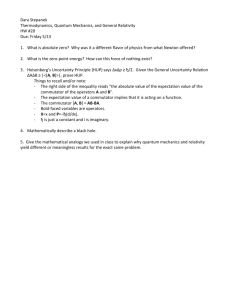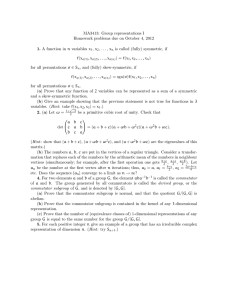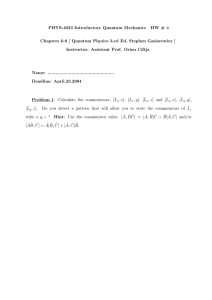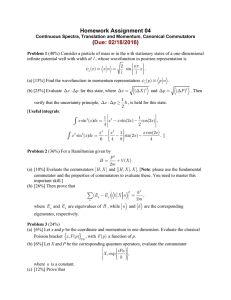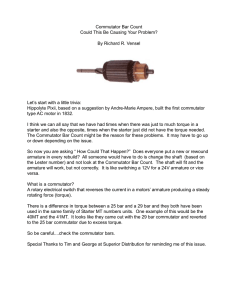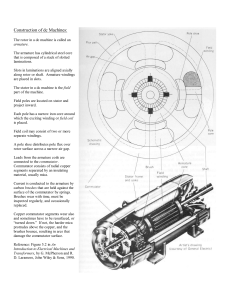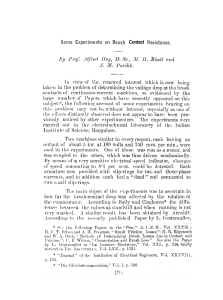IS 14569 (1999): Commutators for Electrical Machines
advertisement
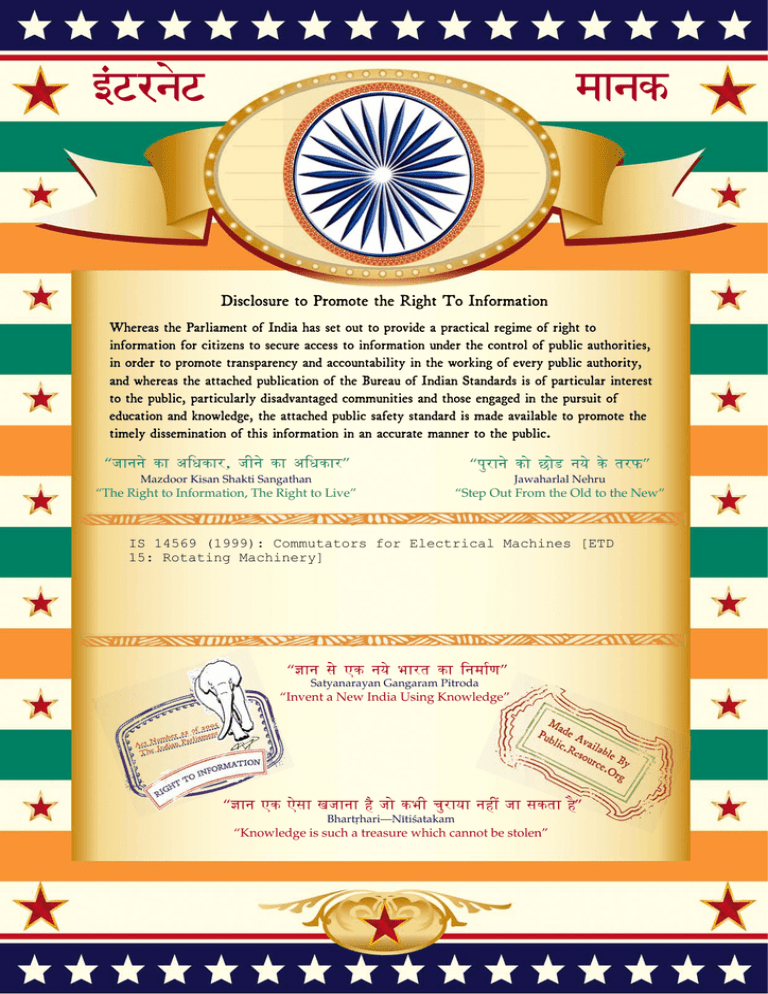
इंटरनेट
मानक
Disclosure to Promote the Right To Information
Whereas the Parliament of India has set out to provide a practical regime of right to
information for citizens to secure access to information under the control of public authorities,
in order to promote transparency and accountability in the working of every public authority,
and whereas the attached publication of the Bureau of Indian Standards is of particular interest
to the public, particularly disadvantaged communities and those engaged in the pursuit of
education and knowledge, the attached public safety standard is made available to promote the
timely dissemination of this information in an accurate manner to the public.
“जान1 का अ+धकार, जी1 का अ+धकार”
“प0रा1 को छोड न' 5 तरफ”
“The Right to Information, The Right to Live”
“Step Out From the Old to the New”
Mazdoor Kisan Shakti Sangathan
Jawaharlal Nehru
IS 14569 (1999): Commutators for Electrical Machines [ETD
15: Rotating Machinery]
“!ान $ एक न' भारत का +नम-ण”
Satyanarayan Gangaram Pitroda
“Invent a New India Using Knowledge”
“!ान एक ऐसा खजाना > जो कभी च0राया नहB जा सकता ह”
है”
ह
Bhartṛhari—Nītiśatakam
“Knowledge is such a treasure which cannot be stolen”
IS 14569:1999
( Reaffirmed 2004 )
mm’%-
fa@tdi~?f
M&lF@z
T-tml&
Indian Standard
COMMUTATORS FOR ELECTRICAL
MACHINES — SPECIFICATION
ICS
29.160.10
0 BIS 1999
BUREAU
MANAK
February
1999
OF
IN DIAN
STANDARDS
BHAVAN, 9 BAHADUR SHAH ZAFAR
NEW DELHI 110002
MARG
Price Group
4
Rotating Machkery
Sectional Committee,
ET 15
FOREWORD
This Indian Standard was adopted by the Bureau of Indian Standards, after the draft finalized by the Rotating
Machinery Sectional Committee had been approved by the Electrotechnical Division Council.
The Commutator is an essential
The function of the commutator
and, to convert the alternating
generator). The present standard
part of direct current or alternating current commutating electrical machines.
is to facilitate the collection or supply of current in the armature conductors
current induced in the armature conductors into a direct current (in case of
would help in streamlining the quality and production of such a part.
For the purpose of deciding whether a particular requirement of this standard is complied with, the final value,
observed or calculated, expressing the result of a test, shall be rounded off in accordance with “IS2:1960 ‘Rules
for rounding off numerical values (revised)’. The number of significant places retained in the rounded off value
should be the same as that of the specified value in this standard.
IS 14569:1999
Indian Standard
COMMUTATORS FOR ELECTRICAL
MACHINES — SPECIFICATION
1 SCOPE
This standard
covers requirements,
dimensions,
tolerances and tests for commutators used in direct
currentlalternating
current motors or generators of
various applications.
2 REFERENCES
The Indian Standards listed
adjuncts to this standard:
1S No.
below
5.2 Commutator assembly is held by steel spiders
known as shell and cap. The shell and cap are held
together by forming rivet and insulated
from the
segment assembly.
are necessary
Title
1885 (Part 35) :
1993
Electrotechnical
vocabulary:
35 Rotating machinery
2464:1963
Built-up
purposes
5885:1977
Copper
revision)
13586:1993
Definitions and nomenclature for
carbon brushes, brush holders, commutators and slip rings for rotating
electrical machinery
mica
5.1 Commutator
segments
and mica separators
assembly is heId by insulating moulding compound
with or without inner metal bush.
for
commutator
Part
electrical
bar
(jlrst
5.3 Commutator should be ‘Arch-bound’ segment
and Mica separator assembly is held together by
insulated
steel spiders known as shell and cap.
Insulated steel spiders are held together by threaded
fasteners.
6 MATERIAL
6.1 Segments
The commutator segments shall conform to IS 5885.
The choice of the copper material between ETP,
FRHC, silver bearing, oxygen free and cadmium
copper shall be subject to agreement between the
manufacturer and the user.
3 TERMINOLOGY
6.2 Commutator
The definitions given in IS 13586 and 1S 1885 (Part
35) shall apply.
4 TYPES
OF COMMUTATORS
The insulation material, if based on built-up mica shall
conform to IS 2464.
Use of other alternative materials like mica paper,
insulation paper or any other material shall be subject
to agreement between the manufacturer and the user.
Commutators may be classified according to type of
-construction. The basic types are:
a)
Moulded type,
b)
Revetted type, and
c)
Built-up industrial type.
Segment Insulation
6.3 Steel Parts (Spiders)
These parts shall be machined from steel bars, steel
castings, plates or forgings. The type and grade of the
material shall be decided between the manufacturer
and the user. In the case of moulded construction with
inner brush, the material of the brush shall be steel or
brass or as agreed between the manufacturer and the
user.
NOTE — Generally the type of construction of a commutator
for a~articular electric machine is selected based on the design
type specified by the user (manufacturer of electric machine).
Construction types other than those mentioned above may also
be used, if required by the user,
5 CONSTRUCTION
The commutator is an assembly of wedge shaped
conducting members called segments insulated from
each other by mica separators.
Wedge shaped
segments
and mica separation
form a circular
assembly.
The type of commutator
assembly
determines how this is held together as shown in
Fig. 1 to 3.
7 DIMENSIONS
AND TOLERANCES
7.1 Dimensions
Unless otherwise specified, the various dimensions of
the commutator
assembly
shall conform to the
manufacturer’s drawings approved by the user.
1
IS 14569:1999
7.2 Tolerances
The following
limits of tolerances shall be applicable for all types of constructions:
,.
.
.
. ..
H7 or H8 [seeIS919 (Part i )J as per users’ requirement ror
all types of.construction
: h9 [see IS 919 (Part 1)] for moulded and rivetted types +1.0
mm for built-up types
Tolerance
Range
* f).3 mm
: lf3t050mm
for commutator Type A and B
+0.5 mm
: 5.1 to ioomm
for all type commutators
*1.5mm
: 101 to400mm
* 2,0 mm
: 401 to 800 mm
* 3.f) mm
: 801 and above
:
a) Internal diameter
b) Outside diameter of brush seating
c) Total length
e) Radial skew
f) Slot depth
:
:
g) Slot width
h) Concentricity
:
:
between ID and Brush OD
:
j) Slot pitch error
Tolerance
0.3 x Mica separator thickness
0.3 mm, Max
0.4 x Mica separator thickness
51 to 100mm
0.8 mm, Max
0.5 x Mica separator thickness
101 to400mm
1.0 mm, Max
0.6 x Mica separator thickness
401 to 800 mm
1.2 mm, Max
0~8 x Mica separator thickness
801 mm and above
1.5 mm, Max
0.5x Mica separator thickness for all types of commutators
* 5% of the depth for A and B Type commutators
~ 2% mm for slot depth up to 40 mm for Type C
* 3% for slot depth above 40 mm for Type C
+0.05 mm
0.1 mm TIR for Type A and B commutators
0.5 mm TIR for Type C commutators
M.2 mm cumulative.
Range of Length
10t050mm
d) Maximum allowable axial skew
on the commutator segment length
NOTES
1 Method of measurement of slot pitch error-This
is to be measured with isvernier for wider slot widths, For smafler slot width, pins
are to be inserted in two slots (pin diameter should be equal to the slot width) and the distance between pins to be measured with a
vernier,
2 Tolerance for industrial commutator
moulded and rivetted commutators.
segment pitch error should be 0.5 mm for eve[y quadrant of the commutator
the Rules and Regulations made thereunder. The
details of conditions under which the Iicence for use
of Standard Mark may be granted to manufacturers or
producers may be obtained from the Bureau of Indian
Standards.
8 PACKING
Commutator should be packed in a suitable container
to avoid damage to any part or surface of the
commutators due to shocks. The container should be
water proof and moisture proof.
10 TESTS
9 MARKING
9.1 The manufacturers’ identification
placed on the commutators.
and 0.2 mm for
10A Type Tests
marks shall be
The following shall constitute the type tests:
a) Inters;gment short circuit test (see 11.1),
b, High voltage test (see 11.2),
c) Humidity test (for moulded type commutators
only) (see 12), and
d) Spin test (see 13).
9.1.1 The commutators may also be marked with the
Standard Mark.
9.1.2 The use of the Standard Mark is governed by the
provisions of Bureau of lndian StandardAct, 1986 and
2
IS 14569:1999
10.2 Routine Tests
The following shall constitute the routine tests:
a) Bar to bar short circuit test (see 11.1),
b) Flash test (see 11.2), and
c) Insulation resistance test (see 11.3).
11.3.2 lrrsulation Resistance
mutators
Test for Built-up
ConE
Insulation resistance shall be more than 10 IWQ
between shorted segment and the bore when checked
with a 500 V megger at room temperature.
11 ELECTRICAL
TESTS
12 HUMIDITY
11.1 Intersegment
Short Circuit Test
This test is conducted
only for moulded type
commutators. The commutator shall be subjected to
humidity treatment as under:
All the segments shall be checked for intersegment
short circuit by applying AC voltage the value should
be as per the user’s
requirement,
based on
intersegments insulation thickness) through probes of
a high voltage breakdown tester to adjacent segments
for two seconds. The leakage current shall not exceed
5 mA.
11.2 High Voltage Test
This test shall be carried out between the commutator
segments shorted by wrapping with a metallic foil or
braid, and the bush. The test voltage shall be applied
for 60 s and its value shall be subject to agreement
between the manufacturer and the user. Generally,
this test is carried out at 1000 V + two times the rated
voltage of the electrical
machine on which the
commutator will be used, with leakage current not
exceeding 100 mA.
11.3 Insulation
Resistance
11.3.1 [n.sulation Resistance
Commutators
Test
Test for Moulded
The above test shall be conducted with a 500 V megger
between
shorted segments
and the bore of the
commutator.
The IR value shall be more than 50
NK2 at 130”C.
TEST
Temperature
Relative Humidity
Duration
25°C
Not less thm95
24 h.
percent
Immediately
after taking out from the humidity
chamber and wiping the condensate with dry cloth or
blotting paper, the insulation
resistance
of the
commutator when checked in limit with 11.3.1 shall
not be less than 10 MQ at ambient temperature.
13 SPIN TEST
The spin test is conducted (See Annex A) to ascertain
the mechanical stability of the commutator
under
working
conditions.
The commutator
shall be
mounted on a mandrel and a cut made on the brush
surface to reduce the TIR to as little as possible. The
commutator shall then be heated to 140°C and run at
an RPM of 1.2 times the maximum rated speed for a
duration of 1 minute. The test result shall be as follows:
Segment to segment
– 0.004 mm, Max
– 0.010 mm, Max
– 0.005 mm, Max
deflection:
for moulded commutators
for rivetted commutators
for built-up commutators
Change in TIR
– 0.006 mm, Max for moulded commutators
– 0.020 mm, Max for rivetted commutators
– 0.040 mm, Max for built-up commutators
IS 14569:1999
ANNEX
13)
(Clause
TEST
METHOD
A
FOR SPIN TEST AND CHECKING
A and B Type Commutators:
Mount the commutator on the Spin Test mandrel and
cut the brush surface to reduce TIR to the minimum.
Measure and record TIR between centres.
Make
marking on the mandrel and the commutator to ensure
relocation of the commutator
while Spin Testing.
Remove the commutator, heat it in an oven to get
Mount the
commutator
temperature
to 140°C.
commutator in hot condition on the mandrel as per
original position marked. Mount the mandrel and run
at a rev/rein of 1.2 times the maximum rated speed of
the machine for a duration of 1 minute. Check the
commutator for cracks, mica separators flaking and
other changes.
TIR
Measure TIR between centres and record the readings.
Mount the mandrel with commutator on the spin test
machine.
Put a band heater around brush surface
leaving a gap to permit rotation of the commutator.
Run at the slowest rev/rein possible to heat the
commutator
to a temperature
of 155”C.
After
checking the commutator temperature and arsuring it
is 155°C * 5°C, the commutator is to be run to a
rev/rein of 1.2 times the maximum rated speed for a
duration of 5 minutes. Speed is then slowly reduced
to stop rotation and the commutator allowed to cool
to room temperature
without
removing
the
commutator from the mandrel.
Mount the mandrel between centres and measure TIR
and bar deflection.
Change in TIR will be the difference between the
readings before and after spin test. Bar deflection shall
be measured between
adjacent copper bars. Test
result should”be asfollows.
Change in TIR will be the difference between the
readings taken before and after the spin test. Bar
deflecticm will be the reading taken between adjacent
copper bars.
C Type Commntators:
Mount the Commutator on spin test mandrel. Cut the
brush surface to reduce TIR to the minimum possible.
4
.1
5
.
6
E
IS 14569:1999
I
\
\\L
6
I
I
\
7
IS 14569:1999
Bureau of Indian Standards
BIS is a statutory
institution
established under the Bureau o~ Indian Standards Act, 1986 to promote
harmonious developmetrt of the activities of standardization, marking and quality certification of goods and
attending to connected matters in the emm~.
Copyright
No part of these publications
may be reproduced
in any form
BIS has the copyright of all its publications.
This does not preclude
the free use, in the counse of
without the prior permission
in writing of BIS.
implementing
the standard,
of necessary
details, such as sy-mbols and sizes, type or grade designations.
Enquiries relating to copyright be addressed to the Director (Publication),
BIS.
Review of Indian Standards
Amendments are issued to standards as the need arises on the basis of comments. Standards are also reviewed
periodically; a standard along with amendments is reaffirmed when such review indicates that no changes are
needed; if the review indicates that changes are needed, it is taken up for revision. Users of Indian Standards
should ascertain that they are in possession of the latest amendments or edition by referring to the latest issue
of ‘BR3Handbook’ and ‘Standards Monthly Additions%’
/
This Indian Standard has been developed from DOC:No! ET 15 ( 2951 ).
Amendments
Amend No.
Issued Since Publication
Date of Issue
Text Affected
—
BUREAU OF INDIAN STANDARDS
Headquarters:
Telegrams: Manaksanstha
(Common to all offices)
Manak Bhavan, 9 Bahadur Shah,Zafar Marg, New Delhi 110002
Telephones: 3230131,3233375,3239402
Regional Offices:
Central
: Manak Bhavan, 9 Bahadur Shah Zafar Marg
NEW DELHI 110002
Eastern
: 1/14 C.I.T. Scheme VII M, V.I.P. Road, Maniktola
CALCU’ITA 700054
Telephone
3237617,3233841
3378499,3378561
{ 33786.26,3379120
Northern : SCO 335-336, Sector 34-A, CHANDIGARH 160022
603843
{ 602025
Southern ‘: C.I.T. Campus, IV Cross Road, CHENNAI 600113
2350216,2350442
{ 2351519,2352315”
Western
8329295,8327858{ 8327891,8327892
: Manakalaya, E9 MIDC, Marol, Andheri (East)
MUMBAI 400093
Branches : AHMADABAD. BANGALORE. BHOPAL. BHUBANESHWAR.
COIMBATORE. FARIDABAD. GHAZIABAD: GUWAHATI.
HYDERABAD. JAIPUR. KANPUR. LUCKNOW. NAGPUR.
PATNA. PUNE. THIRUVANANTHAPURAM.
Printed at LMs Kay Printers, New Iklhi,
India
